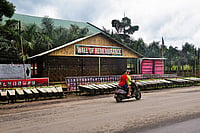Recently, the Government of India decided to confer a Geographical Indication (GI) tag to the Majuli Masks of Assam. Majuli has been a unique repository of art, culture, and tradition for centuries in the state. These masks are often used during festivals like Durga Puja, where mask-wearing is a common practice.
What is GI Tag?
A Geographical Indication (GI) tag is a distinctive sign used to identify products originating from a specific geographical location, possessing unique qualities, characteristics or reputation attributable to that region. It serves as a form of intellectual property, acting as a certification of the product's authenticity and origin. The GI tag confers legal protection, allowing registered authorized users to prevent misuse and misrepresentation. It enables producers to promote their products more effectively, facilitating market access and fetching premium pricing, thereby benefiting local communities and safeguarding traditional knowledge. GI tags have been granted to various agricultural, natural and manufactured products across the world, promoting their exclusivity and preserving their cultural heritage.
What are Majuli Masks?
The Majuli masks are handcrafted art pieces that have historically adorned the faces of performers in the region's renowned bhaonas (theatrical performances with devotional messages), have their roots deeply embedded in the neo-Vaishnavite tradition introduced by the 15th-16th century reformer saint, Srimanta Sankardeva.
These intricate masks, ranging from those covering just the face to those encompassing the entire head and body of the performer (cho mukha), are not mere accessories but embodiments of the region's rich culture. They depict a diverse array of characters, from gods and goddesses to demons, animals, and birds, each meticulously crafted to bring the stories and legends of the bhaonas to life.
The artistry behind these masks is an indication of the skill and dedication of their makers, who have preserved this centuries-old tradition through generations. The masks are crafted from locally sourced materials such as bamboo, clay, dung, cloth, cotton, and wood, reflecting the harmonious relationship between the artisans and their riverine surroundings.
The Mask and the History
Historically, the mask-making tradition has been concentrated in four prominent sattras (monastic institutions) of Majuli – Samaguri Sattra, Natun Samaguri Sattra, Bihimpur Sattra, and Alengi Narasimha Sattra. These sattras, established by Srimanta Sankardev and his disciples as centres of religious, social, and cultural reform, have been the custodians of this art form, ensuring its preservation and continuity.
One of the most renowned practitioners of this art is Hemchandra Goswami, the sattradhikar (administrative head) of the Samaguri Sattra. Goswami, who traces the origins of mask-making to the 16th century play "Chinha Jatra" performed by Srimanta Sankardev himself, has been instrumental in promoting this art beyond its traditional confines.
In recent decades, efforts have been made to transform mask-making into an economically viable art form, ensuring its sustainability and attracting new generations of artists. Small masks are now gifted alongside traditional gamosas (traditional Assamese towels) during felicitations, while larger masks are sold to tourists visiting Majuli and displayed in exhibitions and galleries, including the prestigious British Museum.
The conferment of the GI tag is a significant milestone in the journey of these masks, as it not only recognizes their uniqueness but also serves as a trademark in the international market. This recognition is a testament to the rich cultural heritage of Assam and the enduring legacy of the neo-Vaishnavite tradition.


























